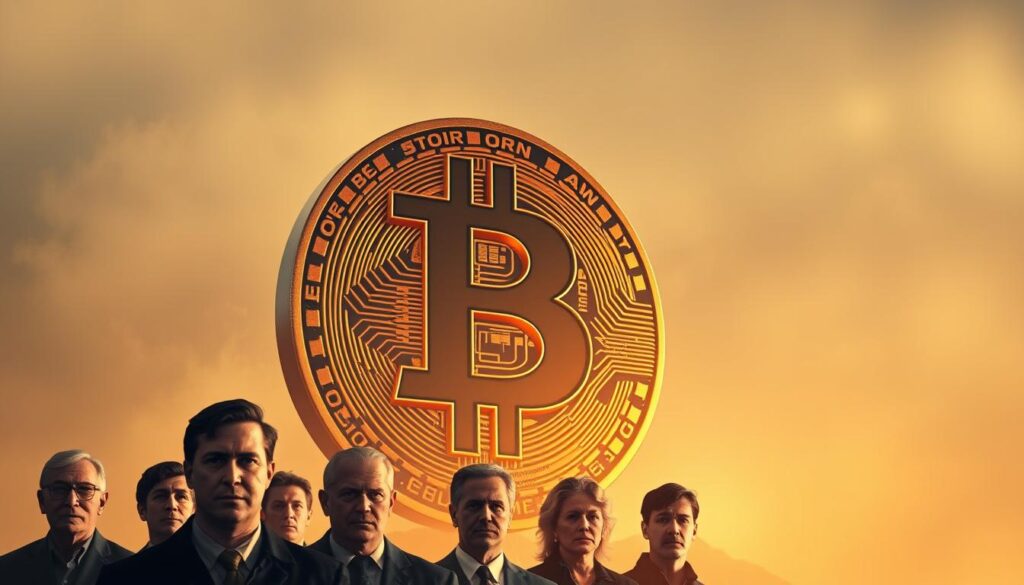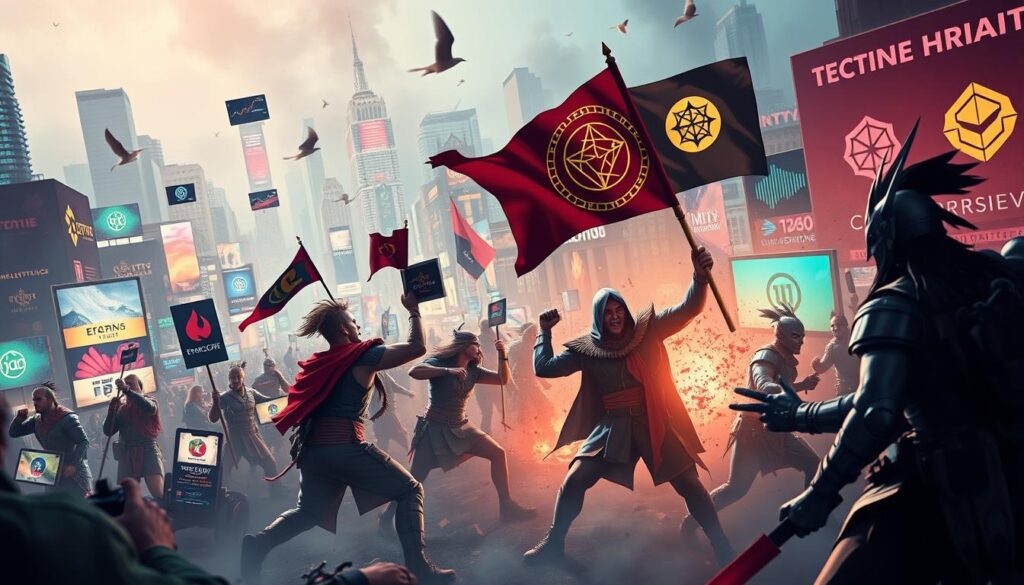Since its 2008 debut, the first decentralized digital currency has reshaped financial systems worldwide. Early adopters championed its decentralized design and fixed supply, sparking a movement that now dominates discussions about value storage and peer-to-peer transactions. Over time, this loyalty evolved into a distinct philosophy prioritizing one network above all others.
The term describing this single-asset focus gained traction in 2014 through a prominent blockchain figure’s observations. Supporters argue that prioritizing security and scarcity protects the network’s integrity. Their conviction fuels ongoing development and safeguards against rapid, untested changes that might compromise core principles.
However, this unwavering commitment creates challenges. While concentrating resources strengthens infrastructure, it may discourage exploration of complementary technologies. The digital asset space now hosts thousands of projects offering specialized features like smart contracts and privacy tools. These alternatives account for nearly half the market, demonstrating diverse user needs beyond basic transactions.
This tension between purity and progress defines modern financial technology debates. Stakeholders must weigh the benefits of streamlined development against opportunities in cross-chain collaboration. How communities navigate this balance will shape the next phase of decentralized systems.
Key Takeaways
- The original decentralized currency maintains over 50% market dominance despite newer competitors
- Single-asset advocates prioritize security and scarcity over feature diversification
- Network loyalty boosts infrastructure development but may slow technical experimentation
- Alternative projects now represent 46% of total digital asset market value
- Industry participants face tradeoffs between specialization and ecosystem collaboration
Understanding Bitcoin Maximalism and Its Origins
The roots of digital asset purism trace back to economic turmoil that reshaped global trust in traditional finance. When banks collapsed in 2008, millions questioned centralized monetary systems. This distrust birthed a peer-to-peer network designed to bypass institutional control.
Historical Background and the 2008 Financial Crisis
Government responses to the recession—like bank bailouts and money printing—highlighted flaws in fiat currencies. Developers created a decentralized ledger to prevent manipulation through fixed supply rules. Early supporters viewed this technology as digital gold, immune to inflationary policies.
By 2014, enthusiasts began arguing that alternative networks diluted core principles. Their stance hardened during technical disputes about transaction capacity. This set the stage for a pivotal conflict over the network’s direction.
The Bitcoin Civil War and Its Impact
Between 2015 and 2017, developers clashed over scaling solutions. One faction wanted larger data blocks for faster payments. Others insisted smaller blocks preserved security and accessibility.
The debate concluded with a compromise called SegWit, which optimized space without changing block size. Dissenting members later launched a spin-off currency, cementing divisions. These events reinforced beliefs that strict protocol rules protect long-term stability.
The Philosophy and Core Beliefs of Bitcoin Maximalists

What drives a community to champion one digital asset above all others? The answer lies in foundational principles shaping financial independence. Supporters argue their approach protects monetary systems from human error and institutional overreach.
Decentralization and Security as Pillars
Maximalists believe distributed networks prevent single points of failure. Unlike traditional finance, no central authority controls transaction validation. This structure resists censorship while maintaining transparency through public ledgers.
Security remains non-negotiable. The network’s proof-of-work mechanism has withstood attacks for 15 years. Supporters highlight this track record when dismissing alternative systems as untested experiments.
Bitcoin as Digital Gold and a Store of Value
The comparison to precious metals stems from scarcity. Only 21 million units will ever exist, creating inherent rarity. This fixed supply contrasts sharply with inflationary fiat currencies.
Bitcoin maximalists emphasize portability and divisibility as upgrades to physical gold. One coin can be split into 100 million subunits, enabling microtransactions. These features position it as a practical store value solution for modern economies.
Critics often question this vision. Yet proponents counter that no other asset combines verifiable scarcity with borderless transfer capabilities. As adoption grows, they foresee global recognition of its store value potential surpassing traditional options.
The Emergence of Crypto Tribalism in the Digital Age

Why do digital asset supporters often act like sports fans defending their favorite team? Over 420 million people now engage with blockchain technologies, creating intense loyalty around specific networks. This phenomenon, called crypto tribalism, transforms technical debates into emotional battlegrounds where communities champion their chosen systems.
Community Loyalty and Ideological Identity
Shared beliefs bind supporters to specific blockchain projects. Members often view their preferred network as superior, creating a “us versus them” mindset. Financial stakes deepen these ties—when a project succeeds, early backers gain both profits and social status.
Online forums magnify this group identity. Platforms like Reddit and X (Twitter) become echo chambers where dissent gets drowned out. Users reinforce shared narratives while dismissing competing ideas as threats to their vision.
Inter-Crypto Conflicts and Rivalries
The 2017 Bitcoin Cash split remains a textbook example. Supporters of both networks still clash over transaction speeds and governance models. Similar tensions exist between Ethereum advocates and those backing newer smart contract platforms.
| Community | Core Focus | Conflict Example |
|---|---|---|
| Privacy Advocates | Anonymous transactions | Monero vs. transparent ledgers |
| Smart Contract Platforms | Decentralized apps | Ethereum vs. Solana |
| Payment Networks | Fast transactions | Bitcoin vs. Litecoin |
Industry leaders warn this infighting could limit broader adoption. Ripple CEO Brad Garlinghouse notes: “Tribal mentalities distract from solving real-world financial challenges.” Yet passionate communities also drive development—their competition sparks technical improvements across the space.
Bitcoin maximalism, crypto tribalism, ecosystem growth, innovation, risk

With over 14,000 projects competing for attention, the digital asset space faces a critical crossroads. The original network commands 54% of total market value, while alternative platforms push boundaries with smart contracts and decentralized apps. This dynamic creates both stability through leadership and friction through competing visions.
Resource allocation patterns reveal a clear divide. Developers working on the dominant chain prioritize security upgrades, while smaller teams experiment with novel functionalities. One approach minimizes systemic vulnerabilities, while the other explores untapped use cases. Market data shows this tension: the top project’s dominance has decreased 18% since 2021 as alternatives gain traction.
“Divisive mentalities prevent collaborative solutions that could benefit all participants,” observes Ripple CEO Brad Garlinghouse.
| Development Focus | Dominant Network | Emerging Platforms |
|---|---|---|
| Primary Objective | Security preservation | Feature expansion |
| Update Frequency | Conservative | Rapid iteration |
| Risk Profile | Low volatility | High experimentation |
This landscape presents strategic dilemmas for investors and builders. Concentrated support ensures robust infrastructure but may delay breakthroughs in scalability. Diversification spreads opportunity across multiple initiatives yet fragments developer talent. The industry’s future hinges on balancing these competing priorities effectively.
Pros of a Maximalist Approach in the Crypto Market
The digital asset landscape reveals stark contrasts in network reliability and market influence. Supporters of a single-chain strategy highlight measurable advantages in infrastructure stability and long-term value preservation.
Architectural Strength and Unmatched Security
With 19,227 active nodes as of July 2024, the primary decentralized network operates with triple the redundancy of major competitors. This distributed structure ensures no single entity controls transaction validation. The system’s proof-of-work mechanism has maintained 100% uptime since 2009 despite processing $15 trillion in annual transfers.
| Network | Active Nodes | Security Incidents |
|---|---|---|
| Bitcoin | 19,227 | 0 |
| Ethereum | 7,101 | 3 major breaches |
Market Leadership and Strong Value Proposition
Controlling 54.38% of total digital asset value, the original network demonstrates lasting investor confidence. Its fixed supply of 21 million units creates scarcity comparable to precious metals, while offering superior portability. Major institutions now allocate portions of treasury reserves to this asset, with MicroStrategy holding 214,246 units worth $13 billion as of Q2 2024.
- 30% faster adoption rate than gold in first 15 years
- Recognized as legal tender in 3 nations
- 85% institutional custody growth since 2021
This combination of technical resilience and monetary policy rigor positions the network as a unique hybrid – part payment system, part value preservation tool. While critics cite limited smart contract capabilities, proponents argue specialization prevents vulnerabilities seen in multi-purpose chains.
Cons and Criticisms of Bitcoin Maximalism
While single-chain advocacy strengthens network security, it raises questions about adaptability in a fast-evolving sector. Critics highlight how rigid frameworks might overlook emerging opportunities in decentralized technology.
Stifling Innovation and Limited Functionalities
Bitcoin maximalism faces scrutiny for potentially slowing technical progress. Alternative chains like Ethereum process transactions 95% faster while enabling programmable agreements. These platforms host over 4,000 decentralized apps—capabilities the original network lacks.
| Feature | Bitcoin | Altcoins | Example |
|---|---|---|---|
| Smart Contracts | Basic scripting | Full programmability | Ethereum |
| Transactions/Second | 7 | 50,000+ | Solana |
| Energy Efficiency | High consumption | Low-impact models | Algorand |
Layer 2 solutions attempt to bridge functionality gaps but face hurdles. The Lightning Network handles 78% more payments since 2022, yet centralization risks persist. Developer Antoine Riard warns: “Current designs could expose users to sophisticated attacks.”
This resistance to cross-chain collaboration may isolate communities. Over $21 billion flows annually into alternative projects addressing healthcare data and supply chain management—areas beyond simple value transfers.
Analyzing Ecosystem Growth Amid Crypto Tribalism
Over 420 million people now interact with digital assets worldwide, creating both momentum and friction. The industry has expanded rapidly, yet faces growing pains as competing visions collide. Newcomers often encounter fragmented communities debating technical merits rather than solving real-world problems.
Adoption Challenges versus Expansion Opportunities
Market data reveals stark contrasts. Only four of 2017’s top 25 projects maintained relevance by 2021, showing how quickly technologies evolve. This volatility deters mainstream users seeking stable platforms for financial services.
Decentralized applications now manage $95 billion in value, proving demand exists. However, tribal mentalities complicate collaboration. Developers working on cross-chain solutions face resistance from purists prioritizing single-network ideals.
The blockchain space stands at a crossroads. While specialization strengthens individual networks, the industry needs shared standards to achieve mass adoption. Recent breakthroughs in privacy-focused tools and payment systems demonstrate what’s possible when teams combine expertise.
Time will determine whether communities unite around common goals or let divisions stall progress. Balancing competitive spirit with cooperative development could unlock the next phase of growth for this evolving ecosystem.
FAQ
How did the 2008 financial crisis shape Bitcoin maximalism?
The collapse of traditional banking systems during the 2008 crisis fueled distrust in centralized institutions. This environment birthed Bitcoin’s decentralized ethos, inspiring maximalists to view it as a hedge against economic instability and a foundation for financial sovereignty.
What role did the Bitcoin Civil War play in today’s ecosystem?
The 2017 debate over block size scalability split the community, hardening maximalist views. This clash emphasized prioritizing security and decentralization over rapid scalability, solidifying Bitcoin’s identity as a settlement layer rather than a transactional currency.
Why do maximalists argue Bitcoin is superior to other blockchains?
Advocates like Michael Saylor highlight Bitcoin’s unmatched proof-of-work security, decentralized network, and finite supply. They argue alternatives compromise on these pillars to prioritize speed or functionality, risking centralization or inflationary models.
How does crypto tribalism affect industry innovation?
While loyalty to specific networks fosters dedicated communities, rigid ideologies can discourage cross-chain collaboration. This risks fragmenting developer talent and slowing progress on interoperability or niche use cases like decentralized identity systems.
Can Bitcoin’s “digital gold” narrative coexist with broader blockchain adoption?
Maximalists like Jack Dorsey see Bitcoin as a foundational store of value, while separate layers (e.g., Lightning Network) handle transactions. Critics argue this limits smart contract potential, forcing users to rely on less secure Layer 2 solutions or alternative chains.
What risks arise from rejecting altcoins entirely?
Dismissing projects like Ethereum or Solana ignores innovations in programmable money and decentralized apps. This stance may alienate developers and investors seeking diverse solutions, potentially slowing mainstream adoption of blockchain technology as a whole.
Does tribalism create adoption barriers for newcomers?
Yes. Conflicting messaging between communities confuses users evaluating crypto’s utility. For example, emphasizing Bitcoin’s scarcity might deter those seeking eco-friendly options, while promoting speculative altcoins could undermine trust in the asset class.
How do maximalists respond to claims of stifling innovation?
They argue Bitcoin’s focus on security and simplicity prevents bloat. Projects building on its base layer (e.g., Fedimint for privacy) demonstrate adaptability without altering core protocols—a “less is more” philosophy aimed at long-term resilience over short-term trends.


